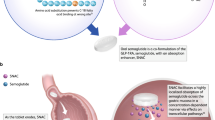Abstract
Background: Bismuthyl ecabet is a combination of sulfodehydroabietic acid and bismuth, which forms a new type of salt that is useful in treating peptic ulcers and gastritis.
Objective: This study was designed to assess the safety and tolerability of bismuthyl ecabet suspension in healthy Chinese subjects.
Methods: For the study 77 volunteers were randomized into single- or multiple-dose groups for oral administration of bismuthyl ecabet 200–1600 mg once daily or 1200 mg twice daily for 7 days. Safety and tolerability were assessed by adverse events, physical examination and serum biochemistry.
Results: In both the single- and multiple-dose studies, no severe adverse events were observed in any of the volunteers. The main adverse events caused by the drug in single-dose groups were an increase in serum alanine transaminase (ALT), γ-glutamyl transpeptidase, blood urea nitrogen, total bilirubin and skin rash. The numbers of adverse events judged to be possibly related to the drug were 2/18 in the 400 mg, 2/18 in the 800 mg, 1/8 in the 1200 mg, and none in the 200 or 1600 mg dose groups. In the multiple-dose studies, an increased serum ALT and aspartate transaminase (AST) was found in one subject after 7 days of administration of the drug. All serum biochemistry returned to normal levels and skin rash resolved after 7 days without any special treatment.
Conclusion: Bismuthyl ecabet was shown to be safe and well tolerated in healthy Chinese subjects. The oral dosing regimen selected for subsequent phase II/III clinical trials was 800 mg twice daily.




Similar content being viewed by others
References
Slomiany BL, Murty VL, Piotrowski J, et al. Gastroprotective agents in mucosal defense against Helicobacter pylori. Gen Pharmacol 1994; 25: 833–41
Wang YQ, Yuan YZ, Meng L, et al. Study of the pharmacokinetics and intragastric pH of rabeprazole administrated by successive intravenous infusion in healthy Chinese volunteers. Eur J Clin Pharmacol 2011; 67: 25–31
Harbison SP, Dempsey DT. Peptic ulcer disease. Curr Probl Surg 2005; 42: 346–454
McArthur KE. Therapy of the uncomplicated ulcer. Semin Gastrointest Dis 1993; 4: 27–38
Umamaheshwari RB, Jain NK. Receptor-mediated targeting of lipobeads bearing acetohydroxamic acid for eradication of Hp. J Control Release 2004; 99: 27–40
Zhang BL, Fan CQ, Dong L, et al. Structural modification of a specific antimicrobial lead against Hp discovered from traditional Chinese medicine and a structure activity relationship study. Eur J Med Chem 2010; 45: 5258–64
Hejazi R, Amiji M. Stomach-specific anti-H. pylori therapy. I: preparation and characterization of tetracyline-loaded chitosan microspheres. Int J Pharmaceut 2002; 235: 87–94
Shibata K, Ito Y, Hongo A, et al. Bactericidal activity of a new antiulcer agent, ecabet sodium, against Helicobacter pylori under acidic conditions. Antimicrob Agents Chemotherap 1995; 39: 1295–9
Lee JH, Kim JJ, Hahm KB, et al. Efficacy and safety of ecabet sodium on functional dyspepsia: a prospective, double-blinded, randomized, multi-center controlled trial. World J Gastroenterol 2006; 12: 2756–61
Ito Y, Onoda Y, Nakamura S, et al. Effects of the new anti-ulcer drug ecabet sodium (TA-2711) on pepsin activity. II. Interaction with substrate protein. Jpn J Pharmacol 1993; 62: 175–81
Kinoshita M, Yamasaki K, Kokusenya Y, et al. Relationship between gastroprotective effect of locally acting antiulcer agent ecabet sodium and its binding to gastric mucosa in rats: comparison with sucralfate. Dig Dis Sci 1995; 40: 661–7
Kinoshita M, Tamaki H. Possible mechanism of increase in gastric mucosal PGE2 and PGI2 generation induced by ecabet sodium, a novel gastroprotective agent. Dig Dis Sci 1997; 42: 83–90
Ichikawa T, Ishihara K, Hayashida H, et al. Effects of ecabet sodium, a novel gastroprotective agent, on mucin metabolism in rat gastric mucosa. Dig Dis Sci 2000; 45: 606–13
Kagaya H, Kato M, Komatsu Y, et al. High-dose ecabet sodium improves the eradication rate of Helicobacter pylori in dual therapy with lansoprazole and amoxicillin. Aliment Pharm Ther 2000; 14: 1523–7
Lawrance IC. Ecabet sodium: a potential new agent in the management of distal colitis. J Gastroen Hepatol 2010; 25: 1181–8
Kono T, Nomura M, Kasai S, et al. Effect of ecabet sodium enema on mildly to moderately active ulcerative proctosigmoiditis: an open-label study. Am J Gastroenterol 2001; 96: 793–7
Koizumi W, Tanabe S, Imaizumi H, et al. Inhibition of peptic ulcer relapse by ranitidine and ecabet independently of eradication of Helicobacter pylori: a prospective, controlled study versus ranitidine. Hepato-gastroenterol 2003; 50: 577–81
Murata H, Kawano S, Tsuji S, et al. Combination therapy of ecabet sodium and cimetidine compared with cimetidine alone for gastric ulcer: prospective randomized multicenter study. J Gastroen Hepatol 2003; 18: 1029–33
Adachi K, Ishihara S, Hashimoto T, et al. Efficacy of ecabet sodium for Helicobacter pylori eradication triple therapy in comparison with a lansoprazole-based regimen. Aliment Pharm Ther 2001; 15: 1187–91
Zhang D, Du XL, Liu MY, et al. Determination of ecabet in human plasma by high-performance liquid chromatography-tandem mass spectrometry. J Chromatogr B 2008; 863: 223–8
Monteleone G, Caprioli F. Drug evaluation: TA-2711E in the treatment of active distal ulcerative colitis. Curr Opin Investig Drugs 2007; 8: 423–8
Chino A, Kishihara T, Uragami N, et al. Re-epithelialization of squamous epithelium for a radiation-induced rectal ulcer while giving an ecabet sodium enema. Dig Endosc 2009; 21: 56–8
Tillman LA, Drake FM, Dixon JS, et al. safety of bismuth in the treatment of gastrointestinal diseases. Aliment Pharm Ther 1996; 10: 459–67
Acknowledgements
Nana Tang and Yongqing Wang contributed equally to this work as co-first authors. This study was supported by Cinmed Pharmaceuticals Co. Ltd, Shanghai, China.
Author information
Authors and Affiliations
Corresponding authors
Rights and permissions
About this article
Cite this article
Wang, Y., Tang, N., Meng, L. et al. Safety and Tolerability of Bismuthyl Ecabet Suspension, a Novel Anti-Ulcer Agent, following Single and Multiple Oral Dose Administration in Healthy Chinese Subjects. Clin Drug Investig 32, 247–252 (2012). https://doi.org/10.2165/11599110-000000000-00000
Published:
Issue Date:
DOI: https://doi.org/10.2165/11599110-000000000-00000




